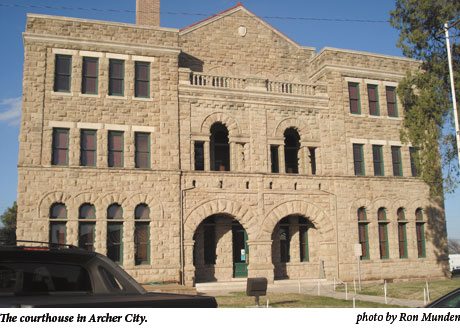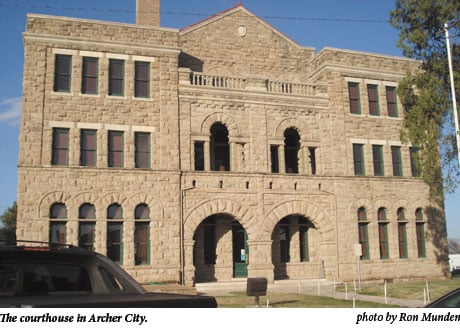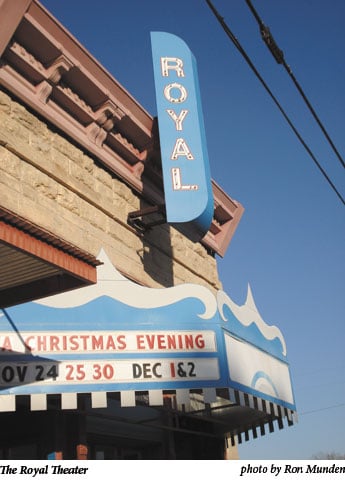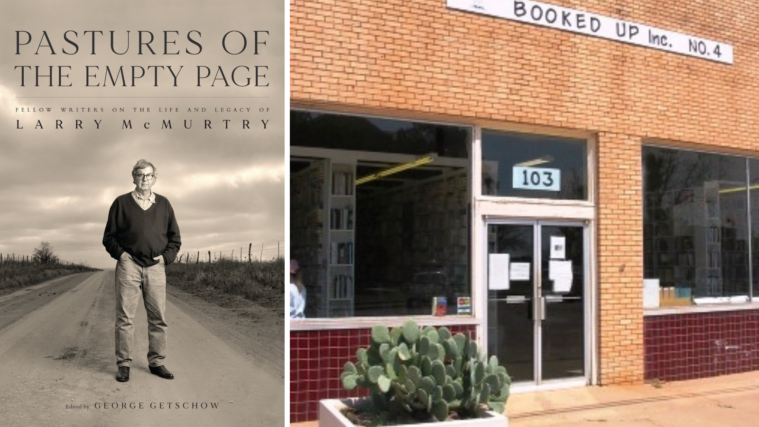
The Last Picture Show, For Real
Above: The courthouse in Archer City, the setting for native son Larry McMurtry's novel The Last Picture Show.
Before white men fought their way from the Sabine River to the Big Bend, the land was covered with grama grass so tall it could tickle a horse’s belly. Buffalo herds migrating across Texas’ plains sounded like the growl of distant thunder.
The buffalo were destroyed, the Comanche and Kiowa who thrived on those herds were penned up on Oklahoma reservations, railroad cars replaced cattle drives, and men whose faces resembled red- rock canyons mourned. The times had shrunk, and so had they.
But something valuable took the frontier’s place in Texas hearts: our small towns. We became tee-totaling Baptists, hymn-singing Methodists, under-the-bright-lights Friday night football fanatics, and irrigated, Alamo-revering Texans.
This is the irony of Texas. We destroyed the plains to build the towns that are now disappearing as well. Thanks to dwindling water supplies, and farm and ranch mechanization, many of the small towns flung between Abilene, Amarillo, and El Paso are vanishing like dust on the wind.
If rural counties and small towns keep losing people at the current pace, by 2040 West Texas and the Panhandle will be as empty as they were in the mid-19th century. Small-town Texas is making a painful transition from real thing to airbrushed memory.
One chapter in the story is being written 25 miles southwest of Wichita Falls in Archer City, the place native son Larry McMurtry made synonymous with a small town’s passage to nowhere in his novel The Last Picture Show.
Archer City’s fate these days could either be seen as a warning on how towns should not react to economic hard times, or a paean to enduring values.
When The Last Picture Show movie was filmed in 1971, Archer City was cast as a semi-ghost town. Most scenes featured two or three people, and no more than 30 appeared in the entire movie.
But the story was set in the 1950s, when Archer City and towns like it were the biggest and most prosperous they had ever been.
Now it is rapidly becoming the ghost town the movie portrays, with the full consent of many Archer residents.
When I saw it last fall, boarded-up businesses surrounded the 1892 sandstone courthouse dozing in the middle of the square, under a big blue sky. There was little traffic to stop at the red light blinking on Main Street. The town’s population has fallen with every census since 1960, and about 1,800 people are left.

Thirty years ago Archer had a hardware store, an appliance store, two department stores, three sit-down restaurants, two grocery stores, seven full-service gas stations, a full-time doctor and hospital, a lumber yard, and a full-service dry cleaners, according to Archer County Judge Gary Beesinger.
Almost all are gone. One of the two remaining sit-down restaurants is a Dairy Queen, and there are three sets of gas pumps, but no full service.
Jobs in town open up only when someone retires or dies, one resident says, so many folks commute to Wichita Falls for work.
McMurtry still owns four rare and used bookstores, all in what’s left of downtown, but that presence does not make everyone happy.
Over the years some people–like Beesinger and businessman Abby Abernathy–have come to believe that what Archer City really needs is to be saved from itself. They have failed to win over the town with that argument.
Abernathy, who grew up on his family’s 8,000-acre Seven Bar Ranch, was in his 20s when he began urging Archer City’s tiny population to try enticing tourists to town, to fill the gaps opening in its failing ranch-and oil-based economy. In his late 30s, he ram-rodded the reconstruction of The Royal Theater (the famed last picture show) and helped create a foundation to oversee its little-theater performances, supper club, and a “Texasville Opry.” In 2002, when he was 40, he became the foundation’s executive director.

Two years later, he gave up and moved to Wichita Falls.
“I did everything I could do,” Abernathy says. “I gave them all I had. … and maybe it was just that I was barking up the wrong tree. Maybe if I had spent the same amount of time developing industry … (things would be different).
“But really, I don’t think it would have mattered. There’s some really good people here, but many are suspicious of change.”
Both Abernathy and Beesinger say they envisioned using the theater, the square’s 19th century buildings (which they hoped would include healthy tourist-oriented businesses), and McMurtry’s book stores to draw people from all over the nation.
Abernathy says promoting the bookstores wasn’t popular because many Archer residents disdain them, and some dislike McMurtry himself.
“The mentality of the city is that Larry is buying up all the buildings and filling them with books, and what do we need books for?” Abernathy says. “They don’t understand what he created, which is a one-of-a-kind, one of the largest collections of rare and used books in the Southwest.”
Beesinger wrote a column in the Archer County News for several years extolling economic development through tourism, arguing that tourists would buy gas, eat at the restaurants, buy books, and stay at the Spur or the Lonesome Dove Inn. But Beesinger was discouraged by the business community’s lack of support and felt he had talked economic development to death. So he changed the column’s focus.
“It’s the same old story. Change is hard to accept, and the fear that comes with change,” Beesinger says, adding that the only things that keeps Archer City from disappearing are the bookstores, the Royal, which has a healthy audience, and the town’s commuters.
Mary Webb, one of McMurtry’s close friends and the proprietor of the Lonesome Dove Inn, says she senses jealousy towards McMurtry. When an Austin theater chain, the Alamo Draft House, brought a giant movie screen to town in 2005 to show The Last Picture Show near the Royal, few locals were among the crowd drawn mainly from Dallas, Austin, Wichita Falls, and Houston.
But McMurtry himself disagrees with Abernathy and Beesinger, calling them “utopians.” He doesn’t think his bookstores will attract more tourists to Archer City, because tourists don’t buy books. If tourists come at all, he says, it’s simply “to see where The Last Picture Show was made.”
What supports “Booked Up Inc.” is not tourists, McMurtry says, but book lovers who come to Archer City to explore his stores, and only to explore the stores. Tour buses disgorge passengers at his bookstores who “are more trouble than they’re worth” because they “damage the stock and get things out of place. Buses are not a guarantee of book sales.,” he says. They also plug up the store’s bathroom.
McMurtry says the town’s ambivalence toward him hasn’t hurt his feelings. He’s spent only three or four nights in Archer City in the past year, and “it would be just as true to say I rejected” the town.
After all, McMurtry says after leaving in the 1950s, he didn’t return to live in Archer for 44 years, when he came home to get his bookstores started because he couldn’t afford to house them in big cities.
“I’m a polarizing figure. I don’t want to be the focus of any town. I don’t want to be the person everybody reacts to. They need another villain, or another hero,” says McMurtry, who now lives in Tucson, among other places.
Undiscouraged by attitudes about McMurtry, Abernathy and Beesinger, in 2002, helped lead the drive for a successful election permitting the town government to use some of its sales tax revenue to fund the Archer City Growth & Development Corp. Voters were told the money would be used to beautify downtown and develop the historic district. It was impossible, supporters argued, to draw healthy businesses—and therefore tourists—to the square without fixing up the downtown buildings.
Things did not go as planned. Instead of spending money on the historic district, the development board used it to attract industry. Only now have board members achieved their first success. The board is providing loans to an aluminum-extrusion plant that will hire five full-time employees, according to the Economic Development board’s volunteer president, Rob Starnes, a 70-year-old retired businessman. He says he hopes more employees will be hired eventually in the future.
Town officials have also agreed to give the plant a tax break for two years. The board says it is trying to give the plant owners an incentive for hiring more full-time employees.
Tourism is “a shot in the dark,” Starnes says. “You don’t know what you’re going to attract, or anything else.” Tourists would “be a benefit, but we are limited what we can do, and we wanted to put money into what we were sure was employment.”
Those who support tourism as a way to revive Archer City “have a point … but what else does Archer City have besides bookstores? You have to have something they want to come and see,” he says.
Starnes says the board has also helped a hog farm expand by allowing the company that owns it to sell bonds through the economic development corporation.
Archer City’s residents are courteous. They acknowledge their town has problems. I walked into the Wildcat Cafe at 6 a.m. on a cold morning. Customers were having their first cups of coffee, and those soft-spoken men did everything but tip their hats and say, “Howdy ma’am.” (The ratio of men to women in the cafe was about 30-to-1 both mornings I was there). That courtesy conceals firm opinions, even a certain amount of despair.
Jerry Morrison, 60, an ex-ranch foreman who says he now takes care of cattle for local landowners, complains the Western values he grew up with are already gone. His son and grandson shot a deer at their barnyard, which is “against the rules of this country.”
“Ranchers used to work together, but they aren’t doing that anymore,” he says, and they are also subdividing their land and selling it, or leasing it to hunters and developers. “Hell yes,” Archer City has a future, he says, “because Wichita Falls is growing down here.” That same growth is “ruining the country,” he says. “They call it a good thing. They call it progress. I ain’t much on progress.”
Clay Reid, 39, who runs Hawley Ranch, agrees. Ranchers are selling their land off, and half the people he sees in Archer City are “rude” strangers. Archer City’s economy has recently improved because the state’s oil industry is booming, says Wayne Browning, 64, a partner in Big Giant, an oil and gas drilling company. Despite the improvement for his business, he says Archer’s older residents are dying and the younger ones are leaving.
Carlton Deen, 64, owner of Deen Drilling and McMurtry’s brother-in-law, believes Archer City has a future if the government doesn’t get in the way, but as far as tourism is concerned, he says, “Maybe we don’t want them.”
There you have it. Archer City shrinks each time a resident dies, or a high school graduate leaves for the big city.
One day, if nothing changes, Archer City will look exactly like it does in The Last Picture Show: a ghost town. In time, most Texas small towns west and north of the Trinity River will follow suit.
It doesn’t necessarily have to be that way. Many Texas towns are turning to tourism, and some have been successful.
Canadian, a Panhandle town near the Oklahoma border, is thriving on the tourist trade, touting its history and even luring tourists to see its prairie chickens.
But Archer’s cowboys and businessmen may have a point. If Archer, and other Texas towns, succeed in attracting tourists, the towns’ characters could be forever changed. It’s a big leap from ranching in the big sky country to antiques and birders on main street.
Either way, deep in the heart of Texas may be disappearing.
When it’s gone, it won’t come back.
Julia Robb is a freelance writer from Marshall, Texas.


